
|
BRHS /
Venting of hydrogen deflagrations with inertial vent covers, jet effectExisting standards, e.g. NFPA 68, address mainly the issue of vent sizing for non-inertial vent covers. However, in various applications only heavy inertial vent closures can be used for technological rea-sons. Most buildings will suffer appreciable structural damage from an internal pressure less than 7 kPa [1]. Deflagration of a hydrogen-air mixture in only 1-2% of an enclosure volume would cause substantial damage. Recent gaseous explosions in domestic structures have shown that new products, such as double glassed windows, can increase the severity of the explosion consequences, up to demolition of most of the building. Most vented deflagrations can be characterised by two pressure peaks. Previous studies have demon-strated that the inertia of the vent cover does influence the value of the first peak, but does not practi-cally influence the second. However, this may not be always the case. An inertial vent cover can affect the second pressure peak in some “implicit” ways. For example, it could happen because of changes in venting generated turbulence, e.g. decrease of turbulence by the gradual opening of the venting area by use of an inertial device. It has been proven that inertial vent covers decrease the maximum turbulence generated during venting, by 20% on average, and by 55% in some experiments with hydrocarbon-air mixtures. This effect could be even more essential for more “sensitive” hydrogen-air mixtures (ex-perimental data are absent at the moment). From another point of view an increase of turbulence could be caused by an increase of vent cover deployment pressure. Indeed, a stronger initial rarefaction wave and consequent pressure oscillations could have a larger effect on the development of flame front wrinkling and hence increase of the burning rate. As another example, it could happen because of changes in the development of “external” explosion during deployment of the inertial vent cover. The jetting of a high-speed flammable mixture into the atmosphere by significantly narrower streams in case of inertial cover deployment contributes to a consequently stronger mixture dilution by air during outflow. This definitely mitigates the external deflagration or could halt it altogether for lean or stoichiometric mixtures of hydrogen with air. Besides, external combustion decreases the pressure drop at the vent and thereby reduces the venting discharge from the enclosure. This in turn causes a higher pressure build up inside the enclosure. Characteristic experimental and simulated (CYNDY code of the University of Ulster) results are pre-sented in the figures below. Figure 1 shows a comparison between theory and experiment [2] for trans-lating vent covers with initially quiescent (test 3-A with a surface density of the vent cover of w=89 kg/m2) and initially agitated by fan (test 3-C, w=42 kg/m2) methane-air mixtures in a 50-m3 enclosure with one 2.45-m2 vent. Two displacement curves for test 3-A are related to two different edges of the vent cover in this particular experiment. The simulated transients are very close to experimental except for the pressure at the final stages of deflagration when the heat losses to the walls reduce the experi-mental pressure. 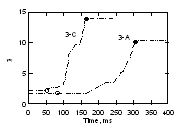  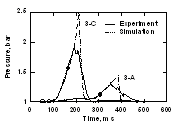
Results for experiments with “butterfly” style hinged vent covers [2] are presented in Fig.2 for a 50-m3 enclosure with two 0.957-m2 vents. The comparison with experiments was performed for quiescent (test 3-B, surface density of w=124 kg/m2) and initially turbulent (3-D, w=73 kg/m2) mixtures. 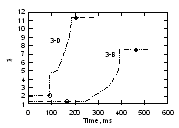 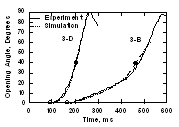 
A comparison between theory and experiment (pentane-air) with a spring-loaded vent cover [3] is shown in Fig.3, which refers to the case of a 1.72-m3 enclosure with a 0.164-m2 vent. The mixture was initially quiescent. The surface density of the vent cover was 245 kg/m2. The stepped change of the turbulence factor at the start of vent cover opening can be explained by the high pressure of vent cover deployment (1.55 bar). 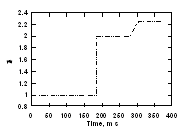 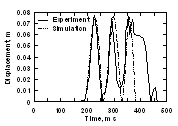 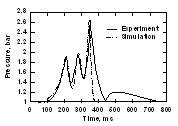
The maximum value of the turbulence factor at the end of the period of its gradual growth in experi-ments with initially turbulent hydrocarbon-mixtures is 70-80% higher than the maximum value for initially quiescent mixtures. It is notable that this difference is larger than the 25-50% initial difference in turbulence factor values due to fan agitation. For the investigated configurations, hinged vent covers result in lower levels of venting generated turbulence than translating vent covers. Vent cover jet effect. This phenomenon was unknown until recently. It significantly affects explosion dynamics in enclosure with inertial vent covers. Several phenomena affecting inertial vent cover dis-placement were examined. The results of the analysis of the drag effect and the air cushioning effect between the moving vent cover and its constraints suggested that these two phenomena were insuffi-cient to account for the experimentally observed displacement of the vent cover. It has been demon-strated that the formation of a jet of flowing out of an enclosure gases on an “internal” surface of the inertial vent cover drastically influences the movement of the cover and hence affects the transient explosion pressure. Mathematical modelling of the pressure distribution, including the jetting flow of explosion products, resulted in a pressure force on the vent cover half that predicted by traditional modelling for translating covers. It was determined by comparison with experiments that the change from full to reduced pressure due to this jet effect becomes significant when the virtual venting area reaches 5-10% of the nominal venting area. The jet effect is crucial to simulating explosion dynamics for all types of venting devices: moving in translation, rotation or spring-loaded [4-7]. References 15. Howard W.B., Karabinis A.H., Tests of explosion venting of buildings, Plant/Operations Progress, 1982, Vol.1, No.1, pp.51-65. |